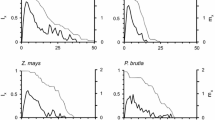Abstract
The generalist predator Amblyseius swirskii is an efficient natural enemy of small insects and phytophagous mites, particularly thrips and spider mites. This phytoseiid species was considered for a long time as a subtropical species and Amblyseius rykei as a sub-Saharan African species. A recent revision of phytoseiid species of the subtribe Amblyseiina from sub-Saharan Africa Zannou et al. (Zootaxa 1550:1–47, 2007) determined that the two species are identical and synonymized them. To confirm or invalidate that morphological study, we crossed a Benin population of A. rykei and an Israel population of A. swirskii through two generations and back-crossed their hybrids to their parents. We also compared demographic parameters of both species on maize pollen, and their predation and oviposition rates on first larval instars of Frankliniella occidentalis. All females of homogamic and heterogamic crosses produced viable progeny, fertile F1 and viable F2. All the laid eggs hatched and sex ratio was female-biased for all crosses. Demographic parameters of the two species on maize pollen, and their predation rates and development times (egg to adult) on first instars of F. occidentalis were similar. Only oviposition of A. swirskii on larvae of F. occidentalis was significantly higher than that of A. rykei. These results indicate that A. rykei and A. swirkii are conspecific, and thus are a single species as concluded by Zannou et al.
Similar content being viewed by others
References
Andrewartha HG, Birch LC (1954) The distribution and abundance of animals. University Chicago Press, Chicago 782 pp
Arthurs S, McKenzie CL, Chen J, Dogramaci M, Brennan M, Houben K, Osborne L (2009) Evaluation of Neoseiulus cucumeris and Amblyseius swirskii (Acari: Phytoseiidae) as biological control agents of chilli thrips, Scirtothrips dorsalis (Thysanoptera: Thripidae) on pepper. Biol Control 49:91–96
Athias-Henriot C (1962) Amblyseius swirskii, un nouveau phytoséiide voisin d’A. andersoni (Acariens anactinotriches). Annales de l’Ecole Nationale d’Agriculture d’Alger 3:1–7
Braun AR, Mesa NC, Cuellar ME, Melo EL, de Moraes GJ (1993) Biosystematics of phytoseiid mites (Acari: Phytoseiidae) associated with cassava. Exp Appl Acarol 17:205–213
Buitenhuis R, Shipp L, Scott-Dupree C (2009) Intra-guild vs extra-guild prey: effect on predator fitness and preference of Amblyseius swirskii (Athias-Henriot) and Neoseiulus cucumeris (Oudemans) (Acari: Phytoseiidae). Bull Entomol Res. doi:10.1017/S0007485309006944
Chant DA, McMurtry JA (2007) Illustrated keys and diagnosis for the genera and subgenera of the Phytoseiidae of the world (Acari: Mesostigmata). Indira Publishing House, West Bloomfield 220 pp
da Aloyséia NSC, de Moraes GJ (2004) Reproductive compatibility between mite populations previously identified as Euseius concordis (Acari: Phytoseiidae). Exp Appl Acarol 32:271–279
de Maia NHA, Luiz BJA, Campanhola C (2000) Statistical inference on associated fertility life table parameters using Jackknife technique: computational aspects. J Econ Entomol 93:511–518
Gerson U, Smiley RL, Ochoa R (2003) Mites (Acari) for pest control. Blackwell Science, Oxford 539 pp
Hale A (2006) Amblyseius swirskii, a new predatory mite available in North America. Bio-control Matters Newsl 7(2):1–9
Kostiainen T, Hoy MA (1996) The Phytoseiidae as biological control agents of pest mites and insects: a bibliography. Univ Fla Agric Exp Station. Monogr 17:1–355
McMurtry JA, Scriven TG (1966) Effects of artificial foods on reproduction and development of four species of phytoseiid mites. Annals of the Entomol Soc Am 59:267–269
Mesa NC, Bellotti AC (1987) Control Biológico con Phytoseiidae de los ácaros dañinos de la yuca. Yuca boletín informativo. Vol. 11 No. 1 SSNOO12-1824. CIAT, A.A. 6713. Cali, Colombia
Messing RH, Croft BA (1991) Biosystematics of Amblyseius andersoni and A. potentillae (Acarina: Phytoseiidae): implications for biological control. Exp Appl Acarol 10:267–278
Moraes GJ, McMurtry JA, Denmark HA, Campos CB (2004) A revised catalog of the mite family Phytoseiidae. Zootaxa 434:1–494
Nomikou M, Janssen A, Schraag R, Sabelis MW (2002) Phytoseiid predators suppress populations of Bemisia tabaci on cucumber plants with alternative food. Exp Appl Acarol 27:57–68
Overmeer WPJ (1985) Rearing and handling. In: Helle W, Sabelis MW (eds) Spider mites, their biology, natural enemies and control, vol 1b. Elsevier, Amsterdam, pp 162–170
Pritchard AE, Baker EW (1962) Mites of the family Phytoseiidae from Central Africa, with remarks on genera of the world. Hilgardia 33:205–309
SAS Institute (2008) Software version 9.2 (TSMO) Cary, North Carolina, USA
Wright RJ (2004) Retail suppliers of beneficial organisms. Nebraska Cooperative Extension NF94-182, Cooperative Extension, Institute of Agriculture and Natural Resources, University of Nebraska-Lincoln, http://ianrpubs.unl.edu/insects/nf182.htm
Zannou ID, de Moraes GJ, Ueckermann EA, Oliveira AR, Yaninek JS, Hanna R (2007) Phytoseiid mites of the subtribe Amblyseiina, tribe Amblyseiini (Acari: Phytoseiidae) from sub-Saharan Africa. Zootaxa 1550:1–47
Acknowledgments
We are grateful to Richard Houndafoché, Clément Kèdédji, Pierre Sovimi for their help in data collecting, Dr. Alexis Onzo and Dr. Muaka Toko for their valuable comments on earlier versions of this manuscript. This research was supported by International Institute of Tropical Agriculture (IITA) core donor funds and with special project funds provided to IITA by the Danish International Development Agency (Danida) and the International Fund for Agricultural Development (IFAD).
Author information
Authors and Affiliations
Corresponding author
Rights and permissions
About this article
Cite this article
Zannou, I.D., Hanna, R. Clarifying the identity of Amblyseius swirskii and Amblyseius rykei (Acari: Phytoseiidae): are they two distinct species or two populations of one species?. Exp Appl Acarol 53, 339–347 (2011). https://doi.org/10.1007/s10493-010-9412-6
Received:
Accepted:
Published:
Issue Date:
DOI: https://doi.org/10.1007/s10493-010-9412-6




